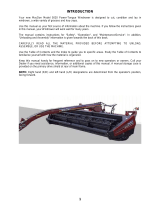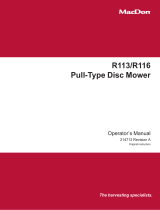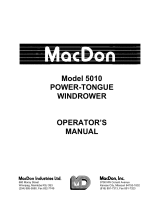Page is loading ...

1
TSUBAKI
CABLEVEYOR
(Cable Carriers)
1
Structure/Part Name
2
Dividers Installation
Install the dividers when inserting cables/hoses.
Follow the steps below with the outside stays open (only the inside stays attached) and install the vertical dividers on the inner
face of the inside stays.
1) Hook the engagement on one side of the vertical divider
into the stay.
2) Push the engagement on the other side of the vertical
divider into the stay by rotating the vertical divider around
the already hooked engagement.
There are two types of vertical dividers shown below.
STAS (Sliding type for DSA)
STAL (Locking type for DSA)
Note) Install the dividers to every second link. Check the number of dividers to be installed per link.
2 holes
1 hole
Instruction Manual
TKR37H28
Caution: Wear suitable protective equipment for the work (such as safety goggles, gloves, and safety shoes).
Moving end bracket
Stay
Moving end bracket
Vertical divider
Link
Link
Fixed end bracket
Fixed end bracket
Lock part
Clamp

2
3
Closing Stays
1) Hook the engagement on one side of the stay into the stay attaching portion
on the link. To attach the stay, push the engagement on the other side of the
stay into the link by rotating it around the already hooked engagement.
2) Check the stay from the side of the
link to ensure that it is attached firmly.
Good:
Not good:
4
Opening Stays
1) Rotate the stay around the engagement on one side of the stay to detach it.
5
Closing Clamps
1) Attach a clamp to the bracket in the same way as for the
stay.
2) Attach the lock parts to both ends of clamp.

3
6
Connection
Long cable carriers (50 links or more) are normally delivered in sections. Follow the procedure below to connect the chains.
Brackets can be attached in the same way. Refer to the previous section for how to detach stays.
1) Remove the stays and lock stays from six or more links
counting from the links to be connected on each end of
chains and align their links with each other.
2) Connect the inside engagement of one link to that of the
link to be connected with.
Enlarged view of enclosed area
Enlarged view of enclosed area
3) Rotate the link around the inside engagement to connect
the outside engagement.
4) Confirm that the outside engagement is securely
connected.
5) Connect the links on the opposite side in the same way and attach the stays.
7
Disassembly
Follow the procedure below to split a cable carrier to fit the required length. Brackets can be detached in the same way.
1) Remove the stays from six or more links on each side of
the desired splitting point, and insert a flathead
screwdriver into the hole on the link.
2) Twist the screwdriver in the direction of the arrow to
detach the link.
Note) Use a flathead screwdriver with a tip width of 3 mm or less.
Cross-section view of
enclosed area
Cross-section view of
enclosed area
Cross-section view of
enclosed area

4
8
Handling Precautions
Depending on the operating conditions, pretension or sagging occurs in the unsupported length portion of the cable
carrier. However, if the product is selected according to the load diagram provided by Tsubaki, it will not cause
problems during operation.
* Any unevenness on the plastic bracket connection surface may damage the bracket. Ensure that the connection
surface is as smooth and flat as possible. Over-tightening fixing bolts can also damage the plastic bracket. Use the
following recommended tightening torque.
Bolt size
Recommended
tightening torque
M4
0.6 N·m
1. Moving end mounting height (H’) onto
machines/equipment should be cable carrier height
H + (30 to 50) mm.
2. The installation space height (h) for the cable carrier
should be H + 100 or more.
3. Install a guide channel.
4. The difference (ε) in connection surface between the
moving and fixed end brackets should be 6 mm or
less.
5. Use highly flexible, wear-resistant cables/hoses that
are intended for movable parts.
6. Avoid using wire-braided cables/hoses as they may
wear easily.
7. As cables/hoses wear easily when used stacked
onto one another, lay them out in a row horizontally
or use horizontal dividers.
8. Set cables/hoses with sufficient length, adjust them
to the proper lengths, and clamp them at both
ends.
9. Remove any foreign matter from the guide
channel as it can cause malfunctions.
10. Dividers are delivered uninstalled. Install them
when installing the cable carrier.
Guide channel
h = H + 100 or more

5
For Safe Use
● Do not use the cable carrier and its accessories (including Cleanveyor and Flatveyor) for anything other
than their original purpose.
● Do not stand or ride on the cable carrier. There is a risk of damage and falls.
● Never perform additional work on the cable carrier or the accessories (except fitting
connectors on Cleanveyor or Flatveyor).
・ Do not clean the cable carrier or the accessories with acids or alkalis, as they may
cause cracking.
・ Never electroplate the cable carrier or the accessories, as this may cause cracking
due to hydrogen embrittlement.
・ Do not weld the cable carrier or the accessories, as the heat may cause cracking or a
reduction in strength.
● Observe all appropriate labor safety codes and standards for your region or area.
● When there is a need to replace a damaged (fractured) portion of a cable carrier or an accessory, always
replace the whole cable carrier or the accessory with a new product rather than replacing only the
damaged or fractured portion.
● Immediately stop using the cable carrier or the accessories if they come into contact with a substance that
can cause embrittlement cracking (acid, strong alkali, battery fluid, etc.) and replace with a new cable
carrier or accessory.
● Observe the following when connecting, installing, removing, servicing, and inspecting the cable carrier or
the accessories.
・ Perform the procedure as specified in the instruction manual, catalog, or documentation specially
provided to the customer.
・ Secure the cable carrier and the accessories so they do not move freely. The cable carrier may move on
its own or collapse under its own weight.
・ Be careful not to pinch, crush, or entangle hands in the
bending section of the cable carrier.
・ Wear suitable clothing and protective equipment for the work
(such as safety goggles, gloves and safety shoes).
・ Always turn off the source power supply beforehand, and take
care not to accidentally operate switches.
・ Only experienced personnel should handle the cable carrier.
● Carefully understand the construction and specifications of the cable carrier or the accessories before
handling.
● Inspect the cable carrier or the accessories for damage during transport before installation.
● The cable carrier or the accessories should be periodically serviced and inspected.
● Cable carrier capacity varies according to manufacturer. When selecting a chain based on a Tsubaki
catalog always use the corresponding Tsubaki product.
● Always ensure that the final customer receives the instruction manual.
・ If you do not have the instruction manual, contact a Tsubaki representative with the product name, series
name, and chain/model number to receive the appropriate manual.
● The product information given in this catalog is mainly for selection purposes. Thoroughly read the
instruction manual before actually using the product, and use it properly.
Issued on April 1, 2023 © Tsubakimoto Chain Co.
WARNING
Observe the following points in order to prevent hazardous situations.
CAUTION
Observe the following points to prevent accidents
/

















